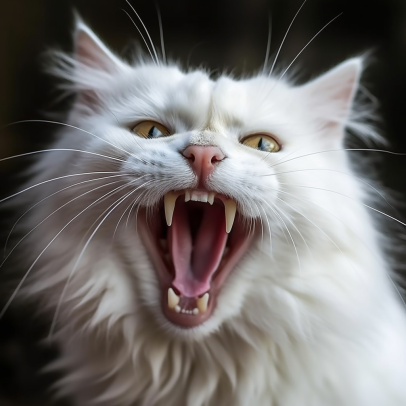Pawsome Pearly Whites: How Many Teeth Do Cats Have?

“Let's dive into the fascinating world of dental anatomy and learn how many teeth us cool cats have.” - Miles the Maine Coon
Introduction
Meow! Welcome to my pawsome guide on a cat's teeth! Let's dive into the fascinating world of dental anatomy and learn how many teeth us cool cats have. It's really important to take care of our teeth, just like humans do. So, buckle up and let's explore the amazing world of cat dental health!
Overview of a Cat's Dental Anatomy
Cat Teeth: My Mysterious Chompers
Hey there, hooman! Did you know that a cat's dental anatomy is super cool? We have two sets of teeth throughout our lives: baby teeth and permanent teeth. It's like having a secret dental upgrade! Understanding how these teeth work is super important for our overall health and happiness.
The Power of Dental Health in Cats
Hey, did you know that dental health is a big deal for us cats? It's not just about looking pretty with a dazzling smile. Good dental care is crucial for our overall well-being. Poor dental hygiene can lead to gum disease, tooth decay, and even infections in other parts of our body. Ouch! So, let's make dental care a priority, shall we?
Adult Cat Dental Structure
Counting Our Teeth: The Cat Math
Okay, let's get into the numbers. Adult cats usually have 30 teeth. That's a lot of teeth to keep track of! These teeth come in different types, like incisors, canines, premolars, and molars. The exact number and arrangement may vary a bit among us cats, but knowing the general dental formula helps take care of each tooth properly.
Baby Teeth vs. Grown-Up Teeth: Spot the Difference!
Guess what? We have a secret dental transformation as we grow up. We start with baby teeth, also known as deciduous teeth, and then our permanent teeth come in. It's like a dental coming-of-age story! Being able to tell the difference between these two sets helps keep an eye on our dental development and catch any issues early on.
The Magic Dental Formula
Here's a secret code for you: the dental formula! It's like a secret handshake for dentists. The dental formula for adult cats is I 3/3, C 1/1, P 3/2, M 1/1, making a total of 30 teeth. This formula tells you the number of incisors (I), canines (C), premolars (P), and molars (M) on one side of the mouth, both top and bottom. Pretty nifty, right?
Kitten Dental Development
Our Tooth Journey: From Tiny Kittens to Fierce Hunters
Hey, did you know that we go through specific stages of dental development just like humans? When we're around two to three weeks old, our baby incisors start popping up, followed by canines and premolars. By the time we're eight weeks old, most of us have a full set of baby teeth. It's important to keep an eye on this development and make sure everything's growing right!
Teeth Eruption: The Teething Tale
Picture this: tiny teeth making their grand entrance. That's what happens when our baby teeth start to come in. The timing might be a bit different for each of us, but usually, the incisors come first, followed by canines and premolars. It's like getting ready to conquer the world of solid food!
Growing Up and Letting Go: The Transition to Big Cat Teeth
As we grow up, our baby teeth need to make way for the permanent ones. It's like a toothy swap meet! This transition usually starts around three to four months old and continues until we're around seven months old. During this time, we might feel a bit of discomfort as we teethe. But don't worry, gentle care and chew toys can make it easier for us!
Function and Purpose of Cat Teeth
The Sharp Truth about Incisors: Grasping and Grooming
Hey, hooman, let's talk about our front teeth, the incisors. They're the little helpers at the front of our mouth. We use them for grabbing and grooming. They're like little toothbrushes! We can bite into food, nibble, and groom our fur with these handy chompers.
Canines: Our Superhero Teeth!
Prepare to be amazed by our canines, or as I like to call them, my fangs! These long, pointy teeth hang out at the corners of our mouth, and they're built for action. Canines are our superhero teeth. They help us seize and puncture our prey during hunting. And let's not forget, they're pretty intimidating when it comes to self-defense!
Premolars: The Food Grinders
Now, let's move on to our premolars, which are right behind our canines. These teeth have a flatter surface with cusps that help us grind and shear food. Nom, nom, nom! They play a crucial role in the munching process, breaking down bigger pieces of food into smaller, manageable bites before we swallow.
Molars: The Crushing Kings
Last but not least, we have our molars at the back of our mouth. These are the big guns! Our molars are the largest teeth we have, and they're all about chewing and crushing food. They have a broad surface area and a sturdy structure, making sure we can properly process our meals before digestion kicks in.
Common Dental Issues in Cats
Periodontal Disease: A Sneaky Dental Villain
Watch out for periodontal disease, hooman! It's one of the most common dental issues we cats face. This troublemaker is caused by plaque and tartar buildup, leading to inflamed gums, tooth decay, and even tooth loss. Regular dental care and professional cleanings are our best allies against this villain.
Plaque and Tartar Buildup: The Unwanted Guests
Plaque is like a sticky film that hangs around our teeth, thanks to pesky bacteria. If it's not removed, it hardens and becomes tartar. Yuck! Tartar irritates our gums and contributes to periodontal disease. But fear not! Brushing, dental treats, and other oral hygiene practices can help us keep plaque and tartar in check.
Gingivitis and Stomatitis: A Tale of Two Troublemakers
Gingivitis is a fancy word for red and swollen gums, which are often early signs of periodontal disease. But wait, there's more! Stomatitis takes it to the next level—it's severe inflammation of our whole mouth, including gums, tongue, and throat. If you notice any of these troublemakers, it's time for a visit to the vet.
Tooth Resorption: The Painful Intruder
Oh, tooth resorption, you sneaky intruder! This painful condition goes by the name of feline odontoclastic resorptive lesions (FORLs). Basically, it means our body breaks down and reabsorbs our tooth structure. Ouch! This process causes discomfort, tooth loss, and messes with our overall well-being. Regular dental check-ups are key to catching and treating this condition.
Dental Care for Cats
High-Five for Dental Care Routines!
Let's talk about keeping our teeth healthy, hooman. A regular dental care routine is the way to go. It's like a high-five for our pearly whites! Brushing our teeth with a cat-specific toothbrush and toothpaste is essential. And hey, don't forget about chew toys and dental treats. They help reduce plaque and tartar buildup.
Professional Cleanings: The Vet's Magic Touch
Sometimes we need a little extra help from the pros, like our friendly vet. Professional dental cleanings are super important. The vet will remove plaque and tartar, polish our teeth, and give our mouth an overall check-up. Sometimes we might even need a little anesthesia to ensure a stress-free and safe experience.
Food for Thought: Nutrition Matters!
Picking the right food can make a big difference, hooman. Choose a high-quality cat food that supports dental health. Some special foods have kibble shapes and textures that promote chewing and reduce plaque buildup. If you're not sure, ask the vet for dietary recommendations tailored to our needs.
Chew Toys and Dental Treats: Playtime with a Purpose!
Let's have some fun while we take care of our teeth! Chew toys and dental treats designed for cats can help maintain our oral hygiene. They stimulate chewing, which helps remove plaque and tartar from our teeth. Make sure to choose products approved by veterinary professionals and pick the right ones for our age, size, and dental condition.
Signs of Dental Problems in Cats
What's That Smell? Bad Breath Alert!
Hooman, if you notice that our breath could peel paint off the walls, it might be a sign of dental issues. Bad breath can indicate oral infections, gum disease, or tooth decay. So, let's freshen up our breath with a visit to the vet.
Red or Swollen Gums: A Cry for Help
Healthy gums should be pink and firm, not red and swollen. If you notice any of these signs, it could mean gum disease or inflammation is creeping in. Keep a close eye on our gum health, and let the vet know if you spot any changes.
Crunch Time Trouble: Difficulty Eating or Chewing
If we're having trouble eating or chewing, it's time for you to step in, hooman. Dental problems can make mealtime painful for us. If we struggle, avoid certain foods, drop food from our mouth, or chew on one side only, it's essential to have our dental health checked by a veterinarian.
Too Much Drool and Pawing: SOS!
Excessive drooling or pawing at the mouth could be signs that something's not right, hooman. We might be experiencing oral discomfort or pain due to gum disease, toothaches, or mouth sores. Please don't wait! Get us to the vet pronto to address the underlying cause and make us feel better.
Tips for Maintaining Cat Dental Health
Brushing Is Pawsome!
Let's talk about brushing, hooman. It's an essential part of our dental routine. Gradually introduce the brushing process, be patient with us, and reward us with treats or praise to make it a pawsitive experience.
Cat-Friendly Dental Products: The Right Tools for the Job
When it comes to dental products, choose ones made especially for cats. Soft-bristled toothbrushes and cat-safe toothpaste are a must. Steer clear of human toothpaste or products with toxic ingredients that are a big no-no for us kitties.
Vet Visits: A Paw-sitive Experience
Regular dental check-ups with the vet are like playdates but with an important purpose. These visits help catch dental issues early on, maintain our oral health, and keep us smiling. Don't forget to schedule regular check-ups, hooman!
Prevention Is Better than Paw-stponement
Remember, prevention is key! Start our dental care routine early, keep an eye out for any signs of trouble, and address issues promptly. The sooner we start taking care of our teeth, the happier and healthier we'll be in the long run.
Conclusion
Congratulations, hooman! You're now a certified cat dental expert. By understanding our dental anatomy, recognizing common dental issues, and practicing good dental care, you're ensuring our overall well-being. Keep those toothy smiles shining bright, and let's embark on a pawsome journey to optimal dental health together! Meow!

